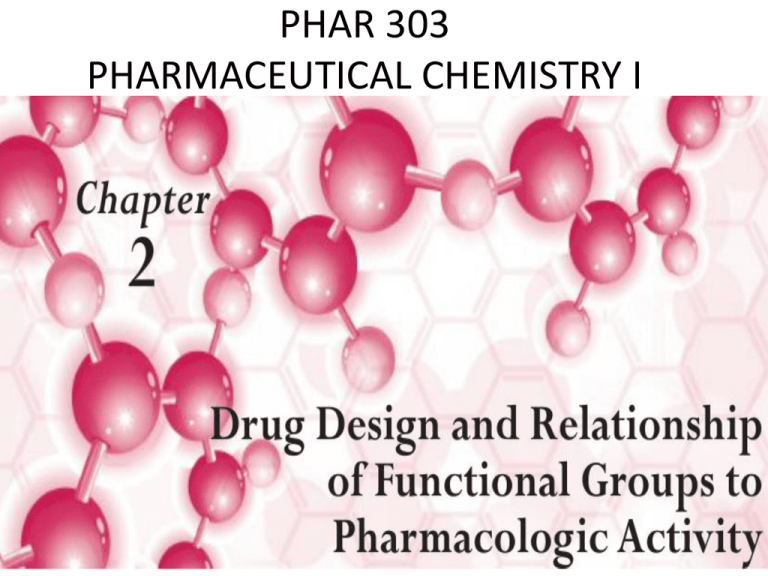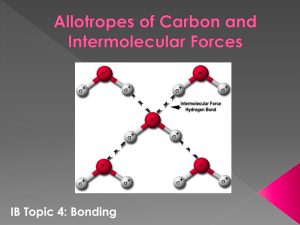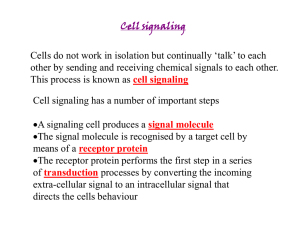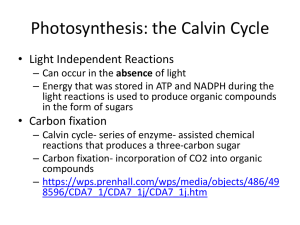
PHAR 303
PHARMACEUTICAL CHEMISTRY I
MOLECULAR STRUCTURE AND BIOLOGIC ACTIVITY
• Chemical compounds, usually derived from plants and
other natural sources, have been used by humans for
thousands of years to alleviate pain, diarrhea, infection,
and various other maladies. Until the 19th century, these
“remedies” were primarily crude preparations of plant
material of unknown constitution. The revolution in
synthetic organic chemistry during the 19th century
produced a concerted effort toward identification of the
structures of the active constituents of these naturally
derived medicinals and synthesis of what were hoped to
be more efficacious agents. By determining the
molecular structures of the active components of these
complex mixtures, it was thought that a better
understanding of how these components worked could
be elucidated.
RELATIONSHIP BETWEEN MOLECULAR
STRUCTURE AND BIOLOGIC ACTIVITY
• Molecular structure influences the biologic activity of chemical
entities and that alterations in structure produce changes in
biologic action.
• The structure of a molecule, its composition and arrangement
of functional groups, determines the type of pharmacologic
effect that it possesses (i.e., SAR).
• SARs are the underlying principle of medicinal chemistry.
Similar molecules exert similar biologic actions in a qualitative
sense. A corollary to this is that structural elements (functional
groups) within a molecule most often contribute in an additive
manner to the physicochemical properties of a molecule and,
therefore, to its biologic action.
• Overall, structural organization also determines selectivity in
activity.
RELATIONSHIP BETWEEN MOLECULAR
STRUCTURE AND BIOLOGIC ACTIVITY
• In the quest for better medicinal agents (drugs), it must be
determined which functional groups within a specific structure
are important for its pharmacologic activity and how these
groups can be modified to produce more potent, more
selective, and safer compounds.
• In order for drug molecules to exhibit their pharmacologic
activity, they must interact with a biologic target, typically an
enzyme, nucleic acid, or excitable membrane or other
biopolymer (RECEPTOR CONCEPT). These interactions
occur between the functional groups found in the drug
molecule and those found within each biologic target.
FACTORS ACTING ON THE BIOLOGICAL
ACTIVITY OF A DRUG MOLECULE
• PHYSICOCHEMICAL PROPERTIES OF DRUGS
- Acid–Base Properties
* Henderson-Hasselbalch Equation, pKa, pH
- Ionization
* Ionizable groups, pKa, Hydrogen bonding
- Water solubility
* Hydrogen bonding, ionization
PHYSICOCHEMICAL PROPERTIES OF DRUGS
Acid–Base Properties
• The human body is 70 to 75% water, which amounts to
approximately 51 to 55 L of water for a 73-kg individual. For
an average drug molecule with a molecular weight of 200
g/mol and a dose of 20 mg, this leads to a solution
concentration of approximately 2 × 10−6 M (2 mM). When
considering the solution behavior of a drug within the body,
we are dealing with a dilute solution, for which the BrönstedLowry (8) acid–base theory is most appropriate to explain and
predict acid–base behavior. This is a very important concept
in medicinal chemistry, because the acid–base properties of
drug molecules have a direct effect on absorption, excretion,
and compatibility with other drugs in solution.
Remember Bronsted Lowry acid-base concept
When an acidic functional group loses its proton (often referred
to as having undergone “dissociation”), it is left with an extra
electron and becomes negatively charged. This is the “ionized”
form of the acid.
When a basic functional group is converted to the
corresponding conjugate acid, it too becomes ionized. In this
instance, however, the functional group becomes positively
charged due to the extra proton.
Functional groups that cannot give up or accept a proton are
considered to be “neutral”
An example
Chemical structure of ciprofloxacin (i.e., a fluoroquinolone antibacterial
agent) showing the various organic functional groups.
Depending on the pH of the physiologic environment, this molecule will
either accept a proton (secondary alkylamine), donate a proton (carboxylic
acid), or both. Thus, it is described as amphoteric (both acidic and basic) in
nature.
Common Acidic Organic Functional Groups and Their Ionized
(Conjugate Base) Forms
Common Basic Organic Functional Groups and Their Ionized
(Conjugate Acid) Forms
Common Organic Functional Groups That are Considered Neutral
Under Physiologic Conditions
Predicting the Degree of Ionization of a Molecule:
The Henderson-Hasselbalch equation for calculating
percent ionization
• By knowing if there are acidic and/or basic functional groups
present in a molecule, one can predict whether a molecule is
going to be predominantly ionized or un-ionized at a given pH.
• The Henderson-Hasselbalch equation (Eq. 2.6) can be used
to calculate the percent ionization of a compound at a given
pH.
An example
Water Solubility of Drugs
• The solubility of a drug molecule in water greatly
affects the routes of administration that are
available, as well as its absorption, distribution, and
elimination. Two key concepts to keep in mind when
considering the water (or fat) solubility of a molecule
are the potential for hydrogen bond formation and
ionization of one or more functional groups within
the molecule.
Hydrogen Bonds
• Each functional group capable of donating or accepting a
hydrogen bond contributes to the overall water solubility of the
compound and increases the hydrophilic (water-loving) nature
of the molecule. Conversely, functional groups that cannot
form hydrogen bonds do not enhance hydrophilicity and will
contribute to the hydrophobic (water-fearing) nature of the
molecule. Hydrogen bonds are a special case of what are
usually referred to as dipole–dipole interactions. A permanent
dipole occurs with each of these atoms along a single bond
(one atom has a partial negative charge, and one atom has a
partial positive charge). The atom with a partial negative
charge has higher electron density than the other atom. When
the positive end of the dipole is a hydrogen atom, this
interaction is referred to as a “hydrogen bond” (or H-bond).
Hydrogen Bonds
• Even though the energy associated with each hydrogen bond
is small (1 to 10 kcal/mol/bond), it is the additive nature of
multiple hydrogen bonds that contributes to the overall water
solubility of a given drug molecule. This type of interaction is
also important in the interaction between a drug and its
biologic target (e.g., receptor).
An example of hydrogen bonding between water and hypothetical drug molecules.
The importance of ionization on water solubility
• In addition to the hydrogen-bonding capacity of a molecule,
another type of interaction plays an important role in
determining water solubility: the ion–dipole interaction. This
type of interaction can occur with organic salts. Ion–dipole
interactions occur between either a cation and the partially
negatively charged atom found in a permanent dipole (e.g.,
the oxygen atom in water) or an anion and the partially
positively charged atom found in a permanent dipole (e.g., the
hydrogen atoms in water).
Examples of ion–dipole interactions.
Drugs and their salt forms
• Organic salts are composed of a drug molecule in its ionized
form and an oppositely charged counterion. For example, the
salt of a carboxylic acid is composed of the carboxylate anion
(ionized form of the functional group) and a positively charged
ion (e.g., Na+) and the salt of a secondary amine is
composed of the ammonium cation (ionized form of the
functional group and a negatively charged ion; e.g., Cl−). Not
all organic salts are very water soluble. To associate with
enough water molecules to become soluble, the salt must be
highly dissociable; in other words, the cation and anion must
be able to separate and interact independently with water
molecules. Highly dissociable salts are those formed from
strong acids with strong bases (e.g., sodium chloride), weak
acids with strong bases (e.g., sodium phenobarbital), or
strong acids with weak bases (e.g., atropine sulfate).
Examples
Water solubilities of different salt
forms of selected drugs.
Another example
• Because of the presence of three very polar functional groups
(two of them being ionizable), one would expect tyrosine to be
very soluble in water, yet its solubility is only 0.45 g/1,000 mL.
The basic alkylamine (pKa 9.1 for the conjugate acid) and the
carboxylic acid (pKa 2.2) are both ionized at physiologic pH,
and a zwitterionic molecule results. These two charged
groups are sufficiently close that a strong ion–ion interaction
occurs, thereby keeping each group from participating in ion–
dipole interactions with surrounding water molecules. This
lack of interaction between the ions and the dipoles found in
water results in a molecule that is very water insoluble
FACTORS ACTING ON THE BIOLOGICAL ACTIVITY OF
A DRUG MOLECULE
• STEREOCHEMISTRY AND DRUG ACTION
• Stereoisomers are molecules that contain the same number and
kinds of atoms, the same arrangement of bonds, but different
three-dimensional structures; in other words, they only differ in
the three-dimensional arrangement of atoms in space. There are
two types of stereoisomers: enantiomers and diastereomers.
Enantiomers are pairs of molecules for which the three-dimensional
arrangement of atoms represents nonsuperimposable mirror
images. Diastereomers represent all of the other stereoisomeric
compounds that are not enantiomers. Thus, the term
“diastereomer” includes compounds that contain double bonds
(geometric isomers) and ring systems. Unlike enantiomers,
diastereomers exhibit different physicochemical properties,
including, but not limited to, melting point, boiling point, solubility,
and
chromatographic behavior. These differences in
physicochemical properties allow the separation of individual
diastereomers from mixtures with the use of standard chemical
separation techniques, such as column chromatography or
crystallization.
FACTORS ACTING ON THE BIOLOGICAL ACTIVITY OF
A DRUG MOLECULE
• STEREOCHEMISTRY AND DRUG ACTION
• Enantiomers cannot be separated using such techniques unless a
chiral environ-ment is provided or if they are first converted to
diastereomers (e.g., salt formation with another enantiomer). The
physicochemical properties of a drug molecule are dependent not
only on what functional groups are present in the molecule but also
on the spatial arrangement of these groups. This becomes an
especially important factor when the environment that a molecule is
in is asymmetric, such as the human body. Proteins and other
biologic targets are asymmetric in nature. How a particular drug
molecule interacts with these macromolecules is determined by the
three-dimensional orientation of the functional groups present. If
critical functional groups in the drug molecule do not occupy the
proper spatial region, then productive interactions with the biologic
target will not be possible. As a result, it is possible that the desired
pharmacologic activity will not be achieved. If, however, the
functional groups within a drug molecule are located in the proper
three-dimensional orientation, then the drug can participate in
multiple key interactions with its biologic target.
FACTORS ACTING ON THE BIOLOGICAL ACTIVITY OF
A DRUG MOLECULE
• STEREOCHEMISTRY AND DRUG ACTION
Approximately one in every four drugs currently on the market is
some type of isomeric mixture. For many of these drugs, the
biologic activity may only reside in one isomer (or at least
predominate in one isomer). The majority of these isomeric
mixtures are termed “racemic mixtures” (or “racemates”). A
racemic mixture is comprised of equal amounts of both possible
drug enantiomers. When enantiomers are introduced into an
asymmetric, or chiral, environment, such as the human body,
they display different physicochemical properties. This can lead
to significant differences in their pharmacokinetic and
pharmacodynamic behavior, resulting in adverse side effects or
toxicity. For example, the individual isomers in a racemic mixture
can exhibit significant differences in absorption (especially active
transport), serum protein binding, and metabolism. As it relates
to drug metabolism, it is certainly possible that only one of the
isomers can be converted into a toxic substance or can influence
the metabolism of another drug.
FACTORS ACTING ON THE BIOLOGICAL ACTIVITY OF
A DRUG MOLECULE
• STEREOCHEMISTRY AND DRUG ACTION
Stereochemistry and Biologic Activity
Easson-Stedman Hypothesis
•
In 1933, Easson and Stedman reasoned that differences in biologic
activity between enantiomers resulted from selective reactivity of
one enantiomer with its receptor. They postulated that such
interactions require a minimum of a three-point fit to the receptor.
Optical isomers. Only in compound 6 do the functional groups
A, B, and C align with the corresponding sites of binding on the
asymmetric surface.
An example: The differences in vasopressor activity of R-(−)epinephrine, S-(+)-epinephrine, and the achiral N-methyldopamine
•
With R-(−)-epinephrine, the three points of interaction with the receptor site
are the substituted aromatic ring, b-hydroxyl group, and the protonated
secondary ammonium group. All three functional groups interact with their
complementary sites on the receptor surface, resulting in receptor
stimulation (in this case). With S-(+)-epinephrine, only two interactions are
possible (the protonated secondary ammonium and the substituted aromatic
ring). The b-hydroxyl group is located in the wrong place in space and,
therefore, cannot interact properly with the receptor. N-methyldopamine can
achieve the same interactions with the receptor as S-(+)-epinephrine;
therefore, it is not surprising that its vasopressor response is the same as
that of S-(+)-epinephrine and less than that of R-(−)-epinephrine.
Homework
• Determine the chiral centers in the molecules below, and draw each
stereoisomer.
Geometric isomers
• Restricted bond rotation caused by carbon–carbon double bonds
(alkenes or olefins) and similar systems, such as imines (C =N), can
produce stereoisomers. These are also referred to as geometric
isomers, although they more properly are classified as
diastereomers. In this situation, substituents can be oriented on the
same side or on opposite sides of the double bond.
Conformational Isomerism
• Conformational isomerism takes place via rotation about one or
more single bonds. Such bond rotation results in nonidentical spatial
arrangement of atoms in a molecule. This type of isomerism does
not require much energy because no bonds are broken. In the
conversion of one enantiomer into another (or diastereomer) bonds
are broken, which requires significantly more energy. The
neurotransmitter acetylcholine can be used to demonstrate the
concept of conformational isomers.
DRUG DESIGN: DISCOVERY AND STRUCTURAL
MODIFICATION OF LEAD COMPOUNDS
• The process of drug discovery begins with the identification of new,
previously undiscovered, biologically active compounds, often called
“hits,” which are typically found by screening many compounds for
the desired biologic properties. We will next explore the various
approaches used to identify “hits” and to convert these “hits” into
“lead” compounds and, subsequently, into drug candidates suitable
for clinical trials. Sources of “hits” can originate from natural sources,
such as plants, animals, or fungi; from synthetic chemical libraries,
such as those created through combinatorial chemistry or historic
chemical compound collections; from chemical and biologic intuition
due to years of chemical–biologic training; from targeted/rational
drug design; or from computational modeling of a target site such as
an enzyme. Chemical or functional group modifications of the “hits”
are performed in order to improve the pharmacologic, toxicologic,
physiochemical, and pharmacokinetic properties of a “hit” compound
into a “lead” compound.
DRUG DESIGN: DISCOVERY AND STRUCTURAL
MODIFICATION OF LEAD COMPOUNDS
• The lead compound to be optimized should be of a known chemical
structure and possess a known mechanism of action, including
knowledge of its functional groups (pharmacophoric groups) that are
recognized by the receptor/active site and are responsible for that
molecule’s affinity at the targeted receptor site. “Lead optimization”
is the process whereby modifications of the functional groups of the
lead compound are carried out in order to improve its recognition,
affinity, and binding geometries of the pharmacophoric groups for
the targeted site (a receptor or enzyme); its pharmacokinetics; or its
reactivity and stability toward metabolic degradation. The final step
of the drug discovery process involves rendering the lead compound
into a drug candidate that is safe and suitable for use in human
clinical trials, including the preparation of a suitable drug
formulation.
DRUG DESIGN: DISCOVERY AND STRUCTURAL
MODIFICATION OF LEAD COMPOUNDS
• 1) Natural Product Screening
• 2) Drug Discovery via Random Screening of Synthetic Organic
Compounds
• 3) Drug Discovery from Targeted Dedicated Screening
• and Rational Drug Design
• 4) Drug Discovery via Drug Metabolism Studies
• 5) Drug Discovery from the Observation of Side Effects
• 6) Pharmacophore generation
• 7) Bioisosterism approach
Natural Product Screening
• Following “leads” from folklore medicine, chemists
of the late 19th and early 20th centuries began to
seek new medicinals from plant sources and to
assay them for many types of pharmacologic
actions. This approach to drug discovery is often
referred to as “natural product screening.” Before
the mid-1970s, this was one of the major
approaches to obtaining new chemical entities as
“leads” for new drugs. Unfortunately, this approach
fell out of favor and was replaced with the rational
approaches to drug design developed during that
period .
Natural Product Screening
Natural Product Screening
------------------------------------
------------------------------------
------------------------------------
Drug Discovery via Random Screening of Synthetic
Organic Compounds
• The random screening of synthetic organic compounds approach to
the discovery of new chemical entities for a particular biologic action
began in the 1930s, after the discovery of the sulfonamide class of
antibacterials.
• This random screening approach was also applied in the 1960s and
1970s in an effort to find agents that were effective against cancer.
Some groups did not limit their assays to identify a particular type of
biologic activity but, rather, tested compounds in a wide variety of
assays.
• This large-scale screening approach of drug “leads” is referred to as
high-throughput screening, which involves the simultaneous
bioassay of thousands of compounds in hundreds to thousands of
bioassays.
Drug Discovery from Targeted Dedicated Screening
and Rational Drug Design
•
•
Rational drug design is a more focused approach that uses greater
knowledge (structural information) about the drug receptor (targets) or
one of its natural ligands as a basis to design, identify, or create drug
“leads.” Testing is usually done with one or two models (e.g., specific
receptor systems or enzymes) based on the therapeutic target. The
drug design component often involves molecular modeling and the use
of quantitative structure–activity relationships (QSARs) to better define
the physicochemical properties and the pharmacophoric groups that are
essential for biologic activity. The development of QSARs relies on the
ability to examine multiple relationships between physical properties
and biologic activities.
This approach needs evaluation of the nature of interaction forces
between a drug and its biological target, as well as the ability to predict
activity in molecules. The methodology is better for the development of
a lead compound into a drug candidate than for the discovery of a lead
compound.
An example: Current Medicinal Chemistry, 2000, 7, 303-339
Drug Discovery via Drug Metabolism Studies
• Metabolites of known drug entities are isolated and assayed for
biologic activity using either the same target system or broader
screen target systems. The broader screening systems are more
useful if the metabolite under evaluation is a chemical structure that
was radically altered from the parent molecule through some
unusual metabolic rearrangement reaction. In most cases, the
metabolite is not radically different from the parent molecule and,
therefore, would be expected to exhibit similar pharmacologic
effects. One advantage of evaluating this type of drug candidate is
that a metabolite can possess better pharmacokinetic properties,
such as a longer duration of action, better oral absorption, or less
toxicity with fewer side effects.
An example
Drug Discovery from the Observation of Side Effects
• Phase 4 studies are referred to as pharmacoviligance nowadays.
The gaining of information not only aids to observe patients
particularly for side effects following the launch of the drug to the
market but also to design new molecules to overcome the side
effects.
• Sometimes side effects might be quite important to identify and
validate a new pharmacological target taht would result in the
generation of new compounds.
• Minoxidil was first discovered and generated for antihypertensive
purpose, nowadays it is used to prevent hair loss though.
Another example
•
Lots sulfonamide drugs were designed and synthesized at the first half of 20th
century for the treatment of bacterial infections. Two examples are below:
•
The side effect common with
these compounds was alkaline
diuresis. Later, it was realized
that due to carbonic anhydrase
inhibition. Even though these
compounds have no use for
antibacterial
activity,
the
mechanism of side effect lead
to
the
generation
of
sulfonamide compouds used
as diuretics in hypertension
treatments either alone or in
combination therapy.
Refinement of the Lead Structure
Determination of the Pharmacophore
• Once a “hit” compound has been discovered for a particular
therapeutic use, the next step is to identify the pharmacophoric
groups. The pharmacophore of a drug molecule is that portion of the
molecule that contains the essential functional group(s) that directly
bind with the active site of the biologic target to produce the desired
biologic activity. Because drug–target interactions can be very
specific (think of a lock [receptor] and key [drug] relationship), the
pharmacophore can constitute a small portion of the molecule.
A r
C O O H
Another example: Thiazide group antidiuretics
Bendroflumethiazide
Chlorothiazide
Hydrochlorothiazide
Methyclothiazide
Another example: Morphine pharmacophore and its
relationship to analgesic derivatives.
Note: Modification to determine pharmacophore groups or hit
molecules can result in drastic changes.
Example: Effect of alkyl chain length on activity of morphine.
Functional Group Modification: Bioisosterism
• When a lead compound is first discovered, it often lacks the
required potency and pharmacokinetic properties suitable for
making it a viable clinical candidate. These can include
undesirable side effects, physicochemical properties, other
factors that affect oral bioavailability and adverse metabolic or
excretion properties. These undesirable properties are often
the result of the presence of specific pharmacophoric
(functional) groups in the molecule. Successful modification of
the compound to reduce or eliminate these undesirable
features without losing the desired biologic activity is the goal.
Replacement or modification of specific phar-macophoric
(functional) groups with other groups having similar properties
is known as “isosteric replacement” or “bioisosteric
replacement.”
Functional Group Modification: Bioisosterism
• Classical Bioisosteres (Groups Within the Row Can
Replace Each Other)
Example: Isosteric replacement of OH by NH 2 in folic acid
and possible tautomers of folic acid and aminopterin.
Example: Tetravalent bioisosteres of a-tocopherol.
Functional Group Modification: Bioisosterism
• Nonclassical Bioisosteric Replacements: replacements of
functional groups not defined by classical definitions.
II. Nonclassical bioisosteres
A. Exchangeable groups
B. Rings versus noncyclic structure
Example: Noncyclic analogs of estradiol.
Example: Bioisosteric replacement of m-OH of isoproterenol
with a sulfonamido group and similar hydrogen-bonding
capacity to a possible drug receptor.
Homework:
• Employing the structure of morphine, show
two bioisosteric approaches. Also state the
type of bioisosterism you choose.








